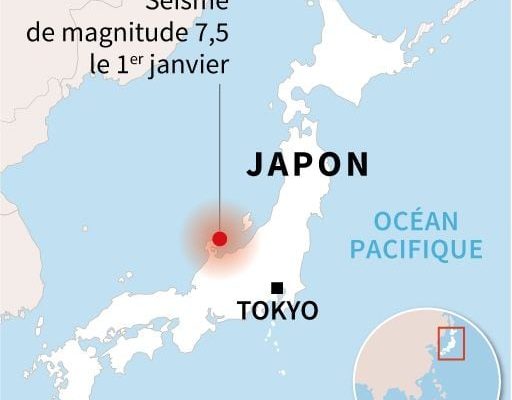Several earthquakes hit central Japan on Monday, January 1, prompting the country’s authorities to issue a tsunami alert and close all highways near the epicenter. “All residents must immediately evacuate to higher ground,” national broadcaster NHK said after several earthquakes hit the Noto peninsula in Ishikawa department after 4 p.m. (8 a.m. in France). “We realize that your homes and possessions are dear to you, but your lives are more important than anything else. Run to the highest areas possible,” added an NHK presenter.
The first waves began to break on the coasts, the country’s meteorological agency JMA said. Waves 1.2 meters high hit the port of Wajima, on the Noto peninsula at the northern tip of Ishikawa department (center), around twenty minutes after the earthquakes, according to the JMA, which warned that waves up to five meters high were possible.
“Dangerous tsunami waves […] are possible within a radius of 300 kilometers around the epicenter along the coast of Japan,” warned the Pacific Tsunami Warning Center (PTWC).
“No anomalies” at the Shika nuclear power plant
The largest of this series of earthquakes, which occurred at 4:10 p.m. (8:10 a.m. French time) at the northeastern tip of the peninsula, was initially recorded at magnitude 7.4, before this was revised. on the rise: 7.5 according to the American Institute of Geophysics USGS, and 7.6 according to the JMA.
Other earthquakes struck a little before or just after the same peninsula: a first of magnitude 5.7 at 4:06 p.m. inland, another of magnitude 6.1 at 4:18 p.m., then again three others of magnitude between 4.5 and 4.8 until 4:32 p.m. local time.
Located on the Pacific Ring of Fire, Japan is one of the countries with the most frequent earthquakes in the world. The archipelago therefore applies extremely strict construction standards, so that buildings are generally resistant to powerful earthquakes, and the inhabitants are experienced in this type of situation, for which they prepare regularly.
But Japan is haunted by the memory of the terrible 9.0 magnitude earthquake followed by a giant tsunami in March 2011 on the northeastern coast of the country, a disaster which left some 20,000 dead and missing. This disaster also led to the Fukushima nuclear accidentthe worst since that of Chernobyl in 1986. “It was confirmed that there were no anomalies at the Shika nuclear power plant (located in the department of Ishikawa, Editor’s note) and at other sites for the moment,” said government spokesperson Yoshimasa Hayash.
